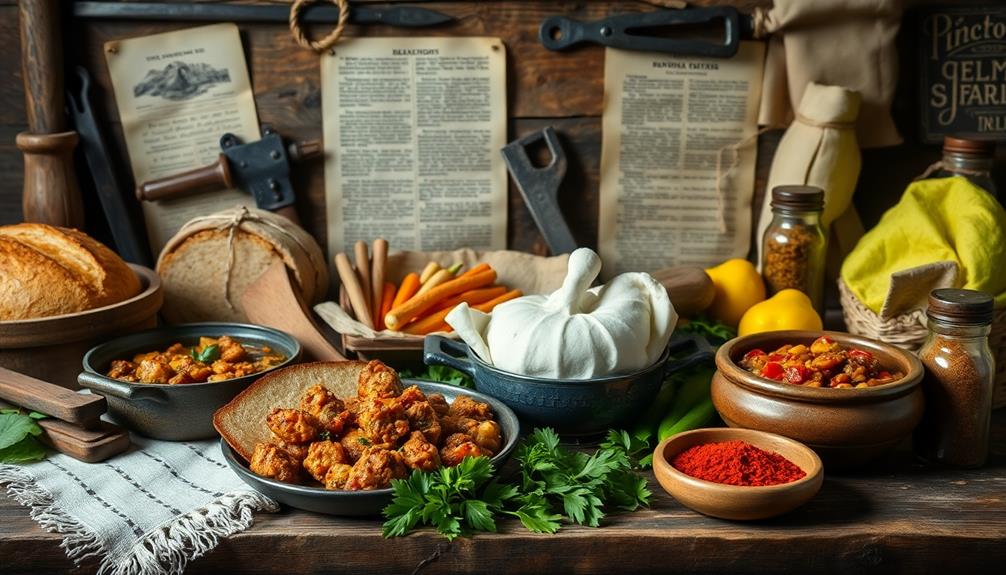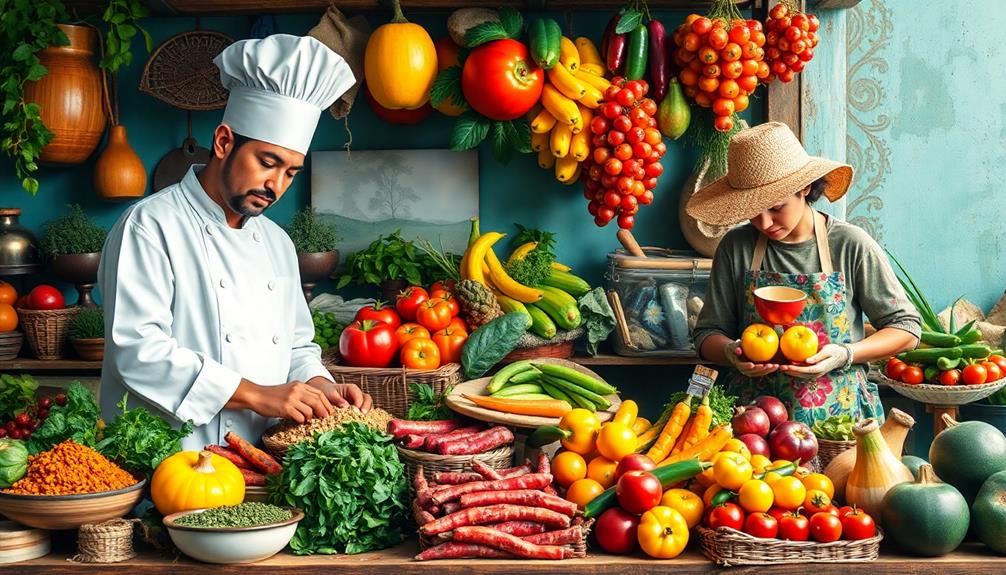Certain foods are closely associated with specific professions due to meeting unique nutritional requirements and reflecting cultural traditions. For example, agricultural workers commonly consume pickled foods, while fishermen prefer seafood dishes that showcase local catches. Miners often opt for calorie-dense meals to fuel their physically demanding work. Meanwhile, culinary professionals focus on utilizing high-quality gourmet ingredients. These dietary preferences extend beyond mere sustenance, influenced by occupational lifestyles and cultural backgrounds, ultimately impacting health and social interactions. Intrigued by how these factors influence eating habits across various occupations? There is plenty more to explore!
Key Takeaways
- Food choices often reflect the nutritional needs and energy demands specific to different professions, such as high-calorie meals for manual laborers.
- Cultural traditions and regional availability of ingredients shape dietary preferences within occupational groups, influencing their meal choices.
- Socioeconomic factors, including education level and economic barriers, significantly impact the dietary habits of various professions.
- Stress levels in high-pressure jobs can lead to unhealthy eating patterns, affecting food preferences and choices in workplace settings.
- Social norms and peer influence within professional environments dictate food consumption, reinforcing specific dietary behaviors among colleagues.
Historical Food Associations

Throughout history, various professions have shaped distinct food associations based on their unique working conditions and dietary needs. For instance, agricultural workers often relied on pickled foods to preserve crops, ensuring they'd sustenance during long hours in the field. These foods not only supported their energy intake but also reflected their dietary habits rooted in practicality and preservation.
Similarly, regional dishes like Caldeirada showcase how specific communities, such as fishermen, utilized local seafood to create hearty meals that fueled their labor-intensive work.
In the early 20th century, miners consumed hearty, high-calorie meals designed to fuel them through labor-intensive shifts in harsh environments. This connection between food and profession highlights how specific cooking skills evolved to meet the demands of their work.
Similarly, fishermen depended on preserved fish and portable foods, creating a strong cultural link to seafood in coastal communities.
Conversely, culinary professionals, like chefs and bakers, are associated with high-quality ingredients and elaborate meals, showcasing their cooking skills and the standards of their establishments. Conversely, culinary professionals, like chefs and bakers, are associated with high-quality ingredients and elaborate meals, showcasing their cooking skills and the standards of their establishments. Their expertise is often reflected not only in the flavors and presentation of their dishes but also in their meticulous kitchen organization and cooking creativity. This combination allows them to efficiently manage time while experimenting with unique ingredients or techniques, resulting in an unforgettable dining experience.
The disparity in food associations also reveals a connection to social class, as upper-class occupations enjoyed gourmet dining while labor-intensive jobs favored simpler, substantial fare to maintain health and energy levels.
Understanding these historical food associations helps you appreciate the deeper ties between your profession and what you eat.
Cultural Influences on Diet

Cultural influences shape your diet in profound ways, often reflecting the agricultural products and culinary techniques that thrive in your region. Your food preferences are deeply intertwined with your cultural background, impacting your dietary practices and occupational food choices. Traditional foods not only provide nourishment but also foster connection and community among those in similar professions.
Here's a look at how cultural influences manifest in various occupations:
| Occupation | Traditional Foods | Dietary Practices |
|---|---|---|
| Farmers | Fresh produce, grains | Seasonal eating |
| Chefs | Regional specialties | Gourmet techniques |
| Healthcare workers | Nutrient-dense meals | Balanced diets |
| Construction workers | Hearty, filling dishes | Energy-boosting meals |
| Teachers | Comfort foods | Celebratory communal meals |
In many professions, certain rituals and celebrations revolve around food, reinforcing group identity. Cultural beliefs can dictate not just what you eat, but when and how you eat. By embracing your culture's culinary heritage, you create a deeper connection to your profession, ensuring that your dietary practices reflect a rich tapestry of tradition.
Nutritional Needs by Profession

When considering your profession, it's essential to recognize that different jobs come with unique nutritional requirements tailored to their physical demands. For instance, if you're in manual labor, your nutritional needs likely include higher protein and caloric intake to support muscle recovery and energy expenditure. Additionally, a hearty meal like Mushroom Masala can provide the necessary nutrients and flavor to keep you energized throughout the day.
On the other hand, if you work in a high-stress environment, like healthcare, a diet rich in omega-3 fatty acids can help mitigate stress effects on mental health and cognitive function.
For knowledge workers who spend long hours sitting, dietary recommendations should focus on brain health, incorporating antioxidants and complex carbohydrates to sustain concentration and energy. Agricultural workers often consume higher amounts of pickles and salt, reflecting their environment and activities, which may lead to increased sodium intake. To optimize mental performance, power foods for the brain—such as fatty fish rich in omega-3s, leafy greens, and nuts—should form a crucial part of the knowledge worker’s diet. These foods can help enhance cognitive function, improve memory, and provide long-lasting energy throughout the workday. Balancing these choices with a proper hydration routine is equally critical to maintaining overall brain and body health.
Moreover, if you're in security, you might find that a higher intake of dairy products and calcium is beneficial, supporting bone health and muscle function due to the physical demands of your role.
Food Symbolism in Careers

Food symbolism in careers reflects a fascinating interplay between your profession and the foods you consume. Your food choices often mirror the dietary habits shaped by your work environment.
For instance, agricultural workers might gravitate towards pickles and salt, both staples in farming life. Similarly, those who enjoy traditional dishes like Muamba De Galinha may find comfort in the rich flavors and communal aspects of their culinary culture.
Conversely, if you're in security, you might find yourself consuming more dairy products, likely due to their availability and the physical demands of your role.
These unique dietary patterns can influence your overall health outcomes, tying your profession to specific nutritional needs. The relationship between your occupation and what you eat goes beyond mere preference; it highlights how workplace settings can enhance or hinder food safety and healthy eating behaviors.
Workplace Environment Effects

The workplace environment can considerably shape your eating habits, often without you even realizing it. Factors like job stress and shift patterns play a significant role in your dietary choices. For instance, if you work in a high-stress role, you might turn to unhealthy snacks as a coping mechanism, leading to detrimental dietary patterns.
Research shows that men are particularly affected by these work-related influences, often opting for quick, convenient foods that don't prioritize nutrition. Additionally, occupations that require physical labor, such as agricultural workers, often lead to a reliance on hearty, nutritious meals to sustain energy levels, which can include dishes like Nettle and Potato Soup that provide essential vitamins and minerals.
Certain occupations, such as security and agricultural workers, display unique dietary patterns that reflect their specific job demands. Stressful working conditions can exacerbate these trends, with studies linking job stress to obesity-related eating behaviors. This underscores the need for effective health promotion strategies tailored to diverse workplace environments.
The Japan Environment and Children's Study highlights substantial variations in dietary intake across different occupations, revealing that your job can directly impact what you eat.
Recognizing these influences can empower you to make better dietary choices, even in challenging work settings. Addressing these factors through workplace health initiatives can lead to healthier habits and improved well-being.
Socioeconomic Factors in Food Choices

In today's society, your occupation markedly influences your food choices and consumption patterns, acting as a key socioeconomic determinant. The dietary intake of various worker groups often reflects their job classifications, revealing notable disparities between professions.
For instance, those in professions with a strong cultural connection to specific cuisines, such as the culinary field, may have a preference for traditional dishes like Red-Braised Pork Belly or other regional specialties. If you're in a lower socioeconomic position, you might face economic barriers that limit your access to nutritious food options, leading to unbalanced diets.
Your education level plays a pivotal role in shaping these food choices. Generally, individuals with higher educational attainment possess better nutrition knowledge, which translates to healthier eating habits. Conversely, those with lower educational backgrounds may struggle to make informed dietary decisions, contributing to health disparities.
Additionally, cultural influences and social contexts within your profession can notably shape your eating behaviors. Family and peer groups often impact your dietary preferences, reinforcing certain eating patterns tied to your work environment.
Frequently Asked Questions
How Does Occupation Influence Food Choices?
Your occupation influences food choices by shaping your environment and daily routines. Depending on your job, you might prioritize convenience, nutrition, or specific cravings, leading to distinct dietary habits that reflect your professional lifestyle.
Why Do People Choose Certain Foods?
You choose certain foods based on cost, availability, and personal preferences. Your background, emotions, and nutritional knowledge also play roles, guiding your cravings and decisions toward meals that satisfy both physiological needs and familiar tastes.
How and Why People Choose the Particular Foods They Eat?
You choose particular foods based on hunger, budget, and physical access. Social influences, emotional states, and attitudes toward nutrition also drive your decisions, shaping what you eat and how you perceive various foods.
What Determines Our Food Preferences?
In your culinary journey, myriad factors shape your food preferences. Biological cues, economic realities, cultural influences, and personal beliefs all intertwine, guiding your choices and cravings, often leading you to unexpected yet delightful dining experiences.
Conclusion
In the grand tapestry of life, food weaves a thread connecting our professions and identities. Just as Shakespeare's characters reveal their essence through their choices, so do you through your meals. The culinary habits tied to your job can reflect not just nutritional needs, but also cultural heritage and social standing. So next time you enjoy a hearty meal at work, remember: you're not just fueling your body; you're participating in a rich narrative that spans history and society.






